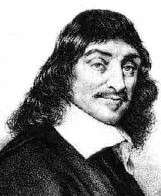

René Descartes was educated at a Jesuit college in Anjou. He entered the college at the age of 8, and studied there for 8 years, studying classics, logic and traditional Aristotelian philosophy. He also learnt mathematics from the books of Clavius.
School had made Descartes understand how little he knew. The only subject which was satisfactory in his eyes was mathematics. This idea became the
foundation for his way of thinking, and was to form the basis for all his works.
Descartes studied at the University of Poitiers, receiving a law degree in 1616. He then enlisted in the military school at Breda. In 1619 he joined the Bavarian army.
From 1620 to 1628, Descartes travelled through Europe. In Paris he met Mersenne, an important contact which kept him in touch with the scientific world for many years. He finally settled in Holland.
Soon afterward, he began work on his first major treatise on physics. This work was near
completion when news that Galileo was condemned to house arrest reached him. He, perhaps wisely, decided not to risk publication and the work was published, only in part, after his death.
In Holland, Descartes had a number of scientific friends as well as continued contact with Mersenne. His friendship with Beeckman continued and he also had
contact with Mydorge, Hortensius, Huygens and van Schooten.
Descartes was pressed by his friends to publish his ideas so he wrote a treatise on science.
This work describes what Descartes considers is a more satisfactory means of acquiring knowledge than that presented by Aristotle's logic. Only mathematics,
Descartes feels, is certain, so all must be based on mathematics.
There were three appendices to this work, on optics, meteorology, and geometry. In optics, there is little new, except his approach through experiment was an important contribution. In meteorology, this work is important for being the first work which attempts to put the study of weather on a scientific basis.
The appendix on geometry, La Géométrie, is by far the most important part of this work. In it, he makes the first step towards a theory of invariants, which at later stages derelativises the system of reference and removes arbitrariness. Algebra makes it possible to recognise the typical problems in geometry and to bring together problems which in geometrical dress would not appear to be related at all. Algebra imports into geometry the most natural principles of division and the most natural hierarchy of method. And not only can questions of solvability and geometrical possibility be decided elegantly, quickly and fully from the parallel algebra, without it they cannot be decided at all.
Descartes' Meditations on First Philosophy was published in 1641, designed for the philosopher and for the theologian. The most comprehensive of Descartes' works, Principia Philosophiae was published in 1644. It attempts to put the whole universe on a mathematical foundation reducing the study to one of mechanics.